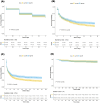Impact of the prognostic nutritional index on renal replacement therapy-free survival and mortality in patients on continuous renal replacement therapy
- PMID: 38874108
- PMCID: PMC11232640
- DOI: 10.1080/0886022X.2024.2365394
Impact of the prognostic nutritional index on renal replacement therapy-free survival and mortality in patients on continuous renal replacement therapy
Abstract
Background: The survival of critically ill patients with acute kidney injury (AKI) undergoing continuous renal replacement therapy (CRRT) is highly dependent on their nutritional status.
Objectives: The prognostic nutritional index (PNI) is an indicator used to assess nutritional status and is calculated as: PNI = (serum albumin in g/dL) × 10 + (total lymphocyte count in/mm3) × 0.005. In this retrospective study, we investigated the correlation between this index and clinical outcomes in critically ill patients with AKI receiving CRRT.
Methods: We analyzed data from 2076 critically ill patients admitted to the intensive care unit at Changhua Christian Hospital, a tertiary hospital in central Taiwan, between January 1, 2010, and April 30, 2021. All these patients met the inclusion criteria of the study. The relationship between PNI and renal replacement therapy-free survival (RRTFS) and mortality was examined using logistic regression models, Cox proportional hazard models, and propensity score matching. High utilization rate of parenteral nutrition (PN) was observed in our study. Subgroup analysis was performed to explore the interaction effect between PNI and PN on mortality.
Results: Patients with higher PNI levels exhibited a greater likelihood of achieving RRTFS, with an adjusted odds ratio of 2.43 (95% confidence interval [CI]: 1.98-2.97, p-value < 0.001). Additionally, these patients demonstrated higher survival rates, with an adjusted hazard ratio of 0.84 (95% CI: 0.72-0.98) for 28-day mortality and 0.80 (95% CI: 0.69-0.92) for 90-day mortality (all p-values < 0.05), compared to those in the low PNI group. While a high utilization rate of parenteral nutrition (PN) was observed, with 78.86% of CRRT patients receiving PN, subgroup analysis showed that high PNI had an independent protective effect on mortality outcomes in AKI patients receiving CRRT, regardless of their PN status.
Conclusions: PNI can serve as an easy, simple, and efficient measure of lymphocytes and albumin levels to predict RRTFS and mortality in AKI patients with require CRRT.
Keywords: Continuous renal replacement therapy; ICU; critically ill patient; mortality; prognostic nutritional index; renal replacement therapy–free survival.
Conflict of interest statement
No potential conflict of interest was reported by the author(s).
Figures




Similar articles
-
Higher body mass index is not a protective risk factor for 28-days mortality in critically ill patients with acute kidney injury undergoing continuous renal replacement therapy.Ren Fail. 2019 Nov;41(1):726-732. doi: 10.1080/0886022X.2019.1650767. Ren Fail. 2019. PMID: 31424314 Free PMC article.
-
SOFA score is superior to APACHE-II score in predicting the prognosis of critically ill patients with acute kidney injury undergoing continuous renal replacement therapy.Ren Fail. 2020 Nov;42(1):638-645. doi: 10.1080/0886022X.2020.1788581. Ren Fail. 2020. PMID: 32660294 Free PMC article.
-
[Effect of early initiation of continuous renal replacement therapy based on the KDIGO classification on the prognosis of critically ill patients with acute kidney injury].Zhonghua Wei Zhong Bing Ji Jiu Yi Xue. 2016 Mar;28(3):246-51. Zhonghua Wei Zhong Bing Ji Jiu Yi Xue. 2016. PMID: 29917340 Chinese.
-
Continuous renal replacement therapy in neonates and children: what does the pediatrician need to know? An overview from the Critical Care Nephrology Section of the European Society of Paediatric and Neonatal Intensive Care (ESPNIC).Eur J Pediatr. 2024 Feb;183(2):529-541. doi: 10.1007/s00431-023-05318-0. Epub 2023 Nov 17. Eur J Pediatr. 2024. PMID: 37975941 Free PMC article. Review.
-
Role of continuous renal replacement therapy in management of the preliver transplant patient.Curr Opin Organ Transplant. 2025 Apr 1;30(2):152-157. doi: 10.1097/MOT.0000000000001194. Epub 2024 Dec 12. Curr Opin Organ Transplant. 2025. PMID: 39665586 Free PMC article. Review.
Cited by
-
Construction of a predictive model for concurrent infection in liver failure patients based on prognostic nutritional index and inflammatory cytokine analysis.BMC Gastroenterol. 2025 Aug 19;25(1):598. doi: 10.1186/s12876-025-04054-z. BMC Gastroenterol. 2025. PMID: 40830428 Free PMC article.
-
Relationship between prognostic nutritional index and asthma: a cross-sectional analysis.Front Nutr. 2025 Feb 6;12:1467270. doi: 10.3389/fnut.2025.1467270. eCollection 2025. Front Nutr. 2025. PMID: 39980673 Free PMC article.
-
Association of prognostic nutritional index with all-cause mortality and cardiovascular mortality: a nationwide population-based cohort study.Front Nutr. 2025 Jul 14;12:1530452. doi: 10.3389/fnut.2025.1530452. eCollection 2025. Front Nutr. 2025. PMID: 40727696 Free PMC article.
-
Predictive Models for CKRT: (A Long) Way to Go.Indian J Pediatr. 2024 Nov;91(11):1113-1114. doi: 10.1007/s12098-024-05225-8. Epub 2024 Jul 27. Indian J Pediatr. 2024. PMID: 39060846 No abstract available.
References
MeSH terms
LinkOut - more resources
Full Text Sources
Other Literature Sources
Miscellaneous
